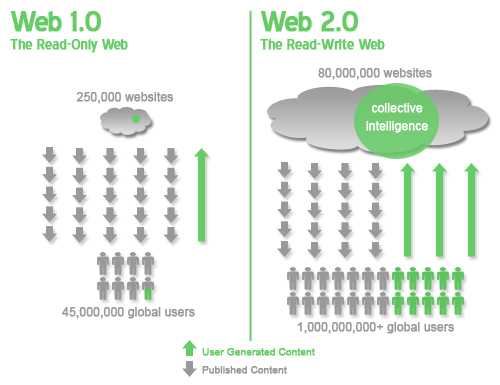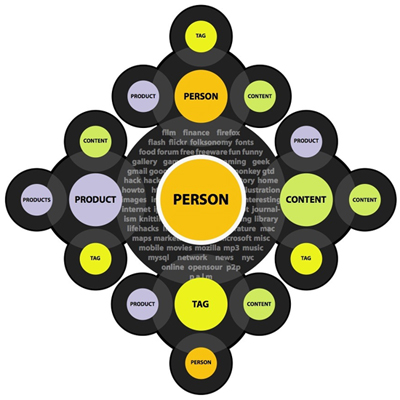What is Web 2.0?
By Kris Themstrup In Social Bookmarking, Social Networking, Web 2.0When it comes to internet marketing, Web 2.0 has redefined the rules. Every fundamental aspect of owning an online business now must incorporate this concept to ensure the potential for positive results. The days of building a site and optimizing it for search engine results are over; there’s someone else who already did that and is moving forward with the next step in their campaign. To win the race, we’ve got to outthink our competitor and outperform them online. To accomplish that, we have to understand the newest concepts in marketing and embrace them as our own. Enter Web 2.0, the natural evolvement of the web and the information within it.
That being said, let’s take a step back. What is Web 2.0? What does it mean and how does it affect marketing and e-commerce? Unfortunately, a concise definition of Web 2.0 has yet to be realized, mostly because it’s an idea that’s still being debated. Wikipedia is the most comprehensive source out there, but it leaves something out in terms of what impact it has had and why it’s important to us. Let’s start by attempting a simple, understandable definition for our purposes.

Web 2.0 is the concept that the internet has evolved into a platform on which users interact and have the ability to own and edit the data within. It is the change from isolated websites with a one-way flow of information to that of free-flowing, open-ended communication and data exchange. Social media, including blogs, social networks and social bookmarking sites are prime examples of Web 2.0. Basically, Web 2.0 is defined by interaction, usually facilitated through the ability to upload as well as download information. The internet is the tool for doing this, and therefore the concept of Web 2.0 is built on this platform, encouraging user-generated content, communication and categorization.
Although the definition might be missing some concrete themes, the websites that are hallmarks of Web 2.0 tell the real story. Take blogs for example. Although they’ve been around for quite some time, they’ve only become a business mainstay in the last 18 months or so. A blog is a platform for interaction. There can be multiple users, contributors and conversations. A blog can allow any type of media sharing, including photos, music, videos, podcasts, etc. A blog allows two-way conversations to happen and encourages user-driven content. If we compare this to a typical e-commerce site, we can see how Web 2.0 allows the user to participate and therefore become part of the process. After all, we’re going to be the ones providing all this data and categorizing it.
Now that we have an idea of what Web 2.0 is, we need to look at what it means and how it affects us. This is arguably where most of the previous rules of e-commerce have been rewritten. Our audience is using the internet differently these days. The amount of data online about products, services and companies is so vast and easily accessed that consumers are presented with a massive supply of choices and information. Because of that, consumers are becoming savvier, using these Web 2.0 fundamentals to research, discuss and share. It’s digital word of mouth advertising, and there’s no shortage of opinions.

So where do we fit in as marketers? If we’re the ones trying to reach these consumers, we must do so on their own ground. We need to go where they are and be perceived as an information source; as a credible, professional company who embraces the technology of the future, not one that hides from it. Web 2.0 allows this is a very profound way. If we contribute to the data, participate in the communities, provide the information, we can reach a highly-coveted group and secure them for a lifetime. It’s truly a marriage between marketers and consumers, and those that are using it effectively are enjoying a lasting relationship.
This all points to the same conclusion: evolve or die. We know our competitors will eventually adopt this approach if they haven’t already. Every study shows the most experienced online marketing companies are going to invest more in the technologies of Web 2.0, like social media and blogs, than ever before. They’ll be spending this money in spite of a recession simply because of the potential return. There’s no need to try and reinvent the wheel when it comes to marketing, but without innovation our business will very quickly become stagnant and stale. There’s a whole community waiting for us out there, and Web 2.0 enables us to interact and tap into the internet’s consumer base like never before, realizing the full potential of our business.
For more information on how Web 2.0 can help your online business, we’re offering a free, no obligation Web 2.0 analysis from a friendly, knowledgeable consultant.


Shane
Thank you Kris, for your thorough research and explanation of the definition and impact of Web 2.0 for business in today’s online market. It’s so amazing to see the internet’s evolution virtually overnight.
Kris
You’re welcome Shane. Now all we have to do is get ready for Web 3.0, what some call the “Semantic Web”. Think of this: what would happen if your computer could read all this data for you rather than you? Don’t search, just ask and the results are exactly what you were looking for. AI (Artificial Intelligence) is fast becoming a reality, and before we know it will have a huge impact on our lives.
Alex
Good job of defining a huge phenomenon with mere words for tools
Kris
In an article from Forrester on Web 2.0, it’s stated that “Enterprise spending on Web 2.0 technologies will grow strongly over the next five years, reaching $4.6 billion globally by 2013, with social networking, mashups, and RSS capturing the greatest share… In 2008, firms will spend $258 million on social networking tools. After blogs and wikis, mashup technology takes off next, growing from a small base of $39 million in 2007 to $682 million in 2013 — second only to social networking.”
Stellathomas
Web 2.0 principals simply take the next step forward, augmenting traditional web content with more dynamic and honest conversations, opening content production to new audiences, introducing new models of participation and supporting new types of client devices and applications.
——————
Stellathomas
Social Bookmarking